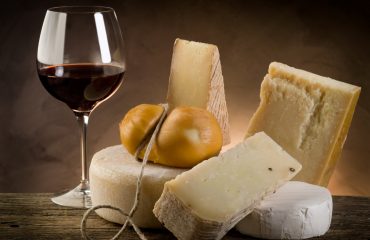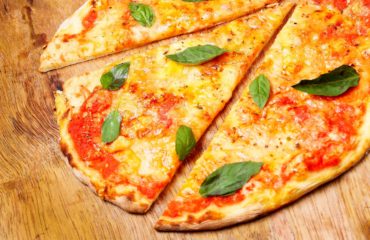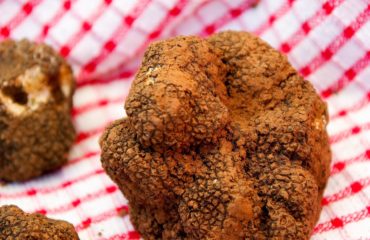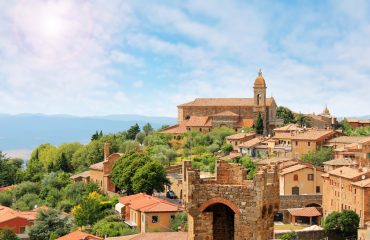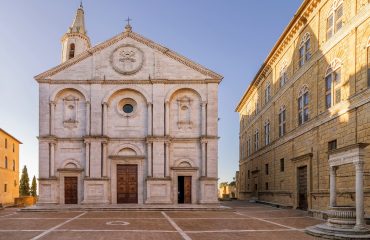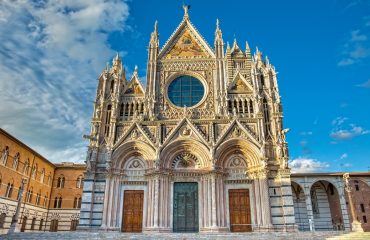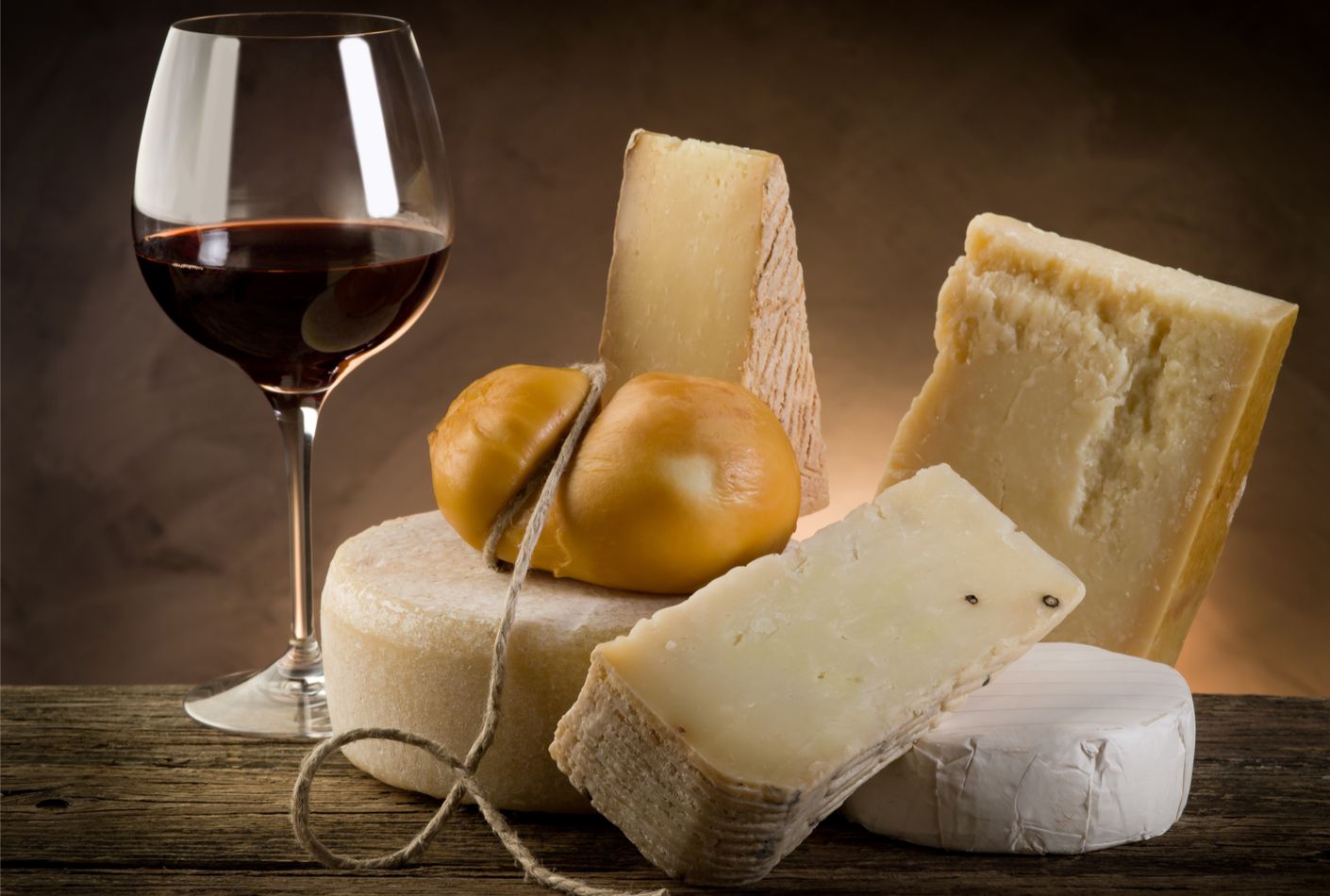
EAT, DRINK AND BE MERRY!
A foodie holiday in Rome, the Orcia Valley & Florence
Starting from €26.000 (for two guests)
- Get to know about Roman gastronomy trends as you whizz round the capital’s choicest eating destinations on the back of a Vespa
- Visit a renowned estate near Montalcino and learn all about the strictly regulated production of Brunello, one of Italy’s most prestigious wines
- Discover traditional recipes and savour the true flavours of Tuscany in a hands-on cooking lesson led by a professional chef
-
Duration11 days / 10 nights
-
Category
-
Day 1
Arrive in Rome
Upon arrival at the airport or train station, meet your private driver and reach your hotel in Rome where you will be staying for 4 nights.
Following check in, which will take place after 2:00 or 3:00 PM, spend the rest of the day at leisure.
-
Day 2
City centre food tour & afternoon tour of Ancient Rome
Munch your way through the Eternal City on this tasty morning passeggiata. Your guide will lead you on a tour through downtown Rome, stopping en route to introduce you to popular local treats.
Much of Italian culture and lifestyle revolves around food and you’ll find out that Rome’s gastronomic triumphs are no less astounding than its artistic and archaeological treasures. An absolute must for gourmands, this experience will give you the chance to wrap your tongue around a wide range of Roman specialities and unveil the yummy side of this multi-faceted metropolis.
Get a flavour of daily life in Italy and dip into the capital’s long-standing delicious traditions as you roam the streets and squares of the centro storico. Your eating adventure begins with a stroll through the lively square of Campo de’ Fiori. Here, savour the sights, scents and sounds of the fresh food bazaar, one of the city’s oldest markets which has been trading the choicest goods since 1869. Hear noisy hawkers loudly proclaim the quality of their wares to encourage passing trade; admire stalls brimming with a tempting assortment of produce that will make your mouth water; feast your eyes on crisp green vegetables, seasonal fruits, delicious cheeses, the freshest of fish; watch bargainers as they haggle for the best deal. Then follow a trail of Rome’s signature aromas, dropping in at nearby food stores to sample typical artisan delights. Scrumptious highlights might include slices of pizza, prime quality cured meats, fried snacks hot from the pan… simply delicious, or better, buonissimo! You will see where Rome’s most acclaimed coffee is made, taste freshly baked goods from a renowned boulangerie and drop in at a well-known family-owned gelateria, since 1900 the creator of the capital’s most celebrated ice cream.
Along the way, your Cicero will point out noteworthy artistic landmarks, relating the true stories that surround them to animate your experience. While you saunter through Piazza Navona, gelato in hand, you will admire Bernini’s glorious Fountain of the Four Rivers and hear tales of the best known rivals in the history of art that will certainly raise a smile. In Piazza della Rotonda, home to a centuries-old salumeria selling high quality cold cuts and cheese, you might want to step inside the Pantheon to see one of the world’s largest free-standing domes with its famous roof open onto the skies. Your walk may end with a glass of wine or craft beer and a toast: long live La Dolce Vita!
Later, it’s time to relive the astonishing feats and glories of the Roman Empire on a private tour of the capital’s ancient wonders. Accompanied by your expert guide, you will travel down the centuries and find out how this small city-state – by dint of perfectly planned military campaigns, outstanding organisation and technological genius – conquered lands far and wide and spread its influence over vast swathes of the globe, rightfully gaining the title of Caput Mundi – Capital of the World.
Specially designed to provide guests with an overview of ancient Roman history, society and culture, this tour encompasses the most significant and iconic archaeological sites. While you follow a time-worn route, past triumphal arches and majestic temples, your guide will bring the ancient city back to life, conjuring up the epic figures who walked along its streets and the world-shaking events that originated on this very spot. Take a deep breath and what you’ve only read about in books now appears right before your eyes!
Your journey begins as you access the Colosseum, the best-known symbol of the mighty Roman Empire and most visited monument in the whole of Italy. This masterpiece of ancient engineering is evidence of the Romans’ brilliant construction skills and provides an eloquent example of their ingenuity and innovation in the fields of technology, science and architecture, achievements which remained unequalled for centuries. The first stone of the amphitheatre was laid in 72 AD at the request of Emperor Vespasian whose intention was to appease public discontent and control the masses by donating a gift to his citizens and win their support with panem et circenses – bread and circuses. The cruel yet spectacular shows of great popular appeal staged inside the Colosseum were like nothing seen before or since, and included mass executions, warrior fights, wild animal hunts and even naval battles. Here, ill-fated prisoners fought to the death before ecstatic crowds and exotic beasts were butchered in the name of entertainment. While you roam through the ruins of stone walls and bleachers, imagine how a gladiator must have felt as he prepared for combat and awaited his destiny, stirred by the roars and cheers of 60,000 blood-thirsty spectators echoing through the arena.
Next, enjoy the myths and stories that took root in Rome on your climb up to Palatine Hill, the oldest part of the Caput Mundi. According to legend, this is where the baby twins Romulus and Remus are said to have been rescued and raised by the she-wolf and it is here that Rome was founded in 753 BC, after a boundary dispute between the two brothers and a fratricide. For centuries this was the city’s most coveted neighbourhood, owing to the stunning views of the Colosseum, the Roman Forum and the Circus Maximus – Rome’s grandiose chariot-racing stadium – to be admired from the top of the hill. The luxurious villas of the patricians were gradually replaced by the emperor’s awe-inspiring palaces. The impressive remains of the Domus Flavia, the Palatine Stadium and the Baths of Septimius Severus still provide an extraordinary glimpse of the opulent lifestyle and excesses enjoyed by the ancient Roman courts.
Your tour will end with a leisurely stroll through the Roman Forum. Originally the social, commercial and political hub of the ancient city, the Forum was a grandiose district of temples and vibrant public spaces where trials, business dealings and elections took place. The marks of the Roman carriage wheels are still visible along its cobbled streets. As you retrace the footsteps of busy market traders and faithful temple-goers, you will learn about the everyday customs of these city dwellers as well as the rituals and beliefs of their pagan creed. Your guide will certainly point out the Curia Iulia, an imposing building that once echoed with the fierce debates of the senators and the rousing speeches of the great orators. You will also see the Temple of Divus Iulius and find out more about the extraordinary achievements and brutal murder of Julius Caesar, the first Roman citizen to be deified after the mythical founder Romulus. Statues of the priestesses who were tasked with ensuring Rome’s sacred flame remained forever lit still line the hall of the House of the Vestal Virgins. Here, you’ll hear moving stories of their lives and sometimes premature, tragic deaths and discuss the role of women in Roman society. Not to be missed are also the Basilica Julia and the Basilica of Maxentius, the most important courthouses of the ancient city.
What was once a busy centre of Roman city life is now still alive and pulsing with visitors eager to step back into history.
After the tour return to your hotel and spend the rest of the day at leisure.
-
Day 3
Vespa food tour and afternoon pizza & gelato making class
Ever seen the classic movie Roman Holiday starring Audrey Hepburn and Gregory Peck? Among their thrilling escapades is a scooter tour of the capital and its romantic locations. Well, now it’s your turn for a ride. Treat yourself to a 21st century remake and imbibe the local culture and lifestyle on this Vespa food tour through the Eternal City.
There is simply no better way of getting about in the capital than Piaggio’s genial, ultra-practical, revolutionary invention. Gourmands will feel the excitement of zipping through Rome’s streets on the pillion of Italy’s best loved vehicle, while savouring the sights and aromas of the city.
Rome can claim the highest concentration of scooters in Europe. Locals are totally in love with their buzzing motorini and, while you roam the capital’s hectic streets, the reason immediately becomes clear: they allow you to move with ease through traffic jams. Vespas, in particular, are one of the country’s most iconic brands. First produced in 1946, the Vespa has become a symbol of the country’s struggle to emerge from the wreckage of World War II. Piaggio – back then operating in the aeronautical field in Pontedera, near Pisa – was completely demolished by bombs during the conflict. Enrico Piaggio, son of Piaggio’s founder Rinaldo, decided to renew the factory in a way that would answer the country’s need for a modern and affordable means of transport. He engaged aeronautical engineer Corradino D’Ascanio to design a simple, robust, 2-passenger vehicle, easy to drive for both men and women, with the aim of getting post war Italy moving again. Did you know that the word vespa means wasp in Italian? When Enrico Piaggio first saw Corradino’s invention he exclaimed “Sembra una vespa!” (“It looks like a wasp!”) – referring to the shape of the scooter and the noise of its engine.
Meet your Vespa drivers outside your hotel, hop on the back of your scooter and set off to enjoy a fun, mouth-watering tour. You will whizz safely round the choicest eating destinations and neighbourhoods that you might have missed or never found time to visit on foot, stopping along the way to sample Roman specialities. This chauffeured ride will lead you to a selection of food sellers – which may include a market, a cafe, a deli store, an ice cream parlour, a bakery and more… – located off the beaten path, outside the centro storico. As you roll around Rome, taking in open-air views of the Eternal City, you’ll get a feel for the local food-centred culture and the gastronomic variety on offer in town. Tasty highlights might include scrumptious slices of pizza, cheeses, cured meats, creamy gelato, a refreshing glass of wine, all topped off by an espresso coffee. An epicurean dream come true!
-
Day 4
Vatican Museums, Sistine Chapel & Saint Peter’s Basilica / Michelin-star dinner
Admire some of the greatest works of art ever created on a private tour of the Vatican Museums, Sistine Chapel and St. Peter’s Basilica. Follow your guide right to the core of the Christian world and uncover the fascinating history preserved within the walls of the Vatican City. You will gain an understanding of the origins and development of a remarkable 500-year-old collection, retrace the lives of the artists who worked at the papal court and reconstruct the context in which the Vatican’s masterpieces were produced. Your guide will enrich your exploration by recounting intriguing tales about the protagonists of what was once one of the West’s most influential seats of power – and is today the smallest independent state in the world.
The beginnings of this unrivalled collection date back to 1506 when art lover Pope Julius II first started arranging his acquisitions of classical sculptures in the Octagonal Courtyard. This extraordinary – though originally modest – assembly of works was enhanced and extended throughout the centuries by successive pontiffs and evolved into the 7-kilometre-long treasure trove you see today. The dazzling array of wonders on display includes artefacts from so many different eras, traditions and artistic styles ranging from Egyptian steles to Renaissance fresco paintings, from Etruscan bronzes to 16th century maps. Where else can you find the finest sculptures of antiquity, priceless tapestries, Michelangelo and Raphael’s supreme achievements, all hanging out in the same space? Your guide will lead you back down the centuries, along a carefully planned trail, through the museum’s corridors and halls – impossible to cover all 1,400 of them! – and introduce you to the masterpieces no visitor should miss.
While you weave your way through the Pinecone Courtyard, the Belvedere Courtyard, the Gallery of the Candelabra, the Hall of Maps and the Tapestries Gallery you will pick up a sense of this encyclopaedic collection spanning thousands of years. No doubt you will be moved at the sight of the Laocoon – a poignant representation of the anguish and agony suffered by a doomed family – and inspired by the aesthetic perfection of the Apollo del Belvedere and Torso del Belvedere. Your guided encounter with these ancient statues will give you a better understanding of Greek and Roman art and the ways in which Renaissance masters were later influenced by their muscular anatomies and emotional intensity.
Among the unmissable highlights of your tour are also Raphael’s Rooms, four exquisitely decorated chambers once belonging to Pope Julius II’s private apartments. Find out why a young painter from Urbino was chosen for such a prestigious commission and enjoy an introduction to the refined iconography of the School of Athens, Raphael’s best-known fresco depicting antiquity’s most illustrious philosophers.
But what draws millions of visitors to the Vatican Museums every year is the spectacular Sistine Chapel. Michelangelo spent eight years of his life in this sacred room painting what would become the most renowned and iconic images in the whole of Western art. As you gaze up at the stunning frescoes of the Creation of Adam and inspect the intricate composition of the Last Judgement your guide will help you spot fascinating details and decipher the secret messages left here by the Renaissance master in the 16th century. An account of Michelangelo’s life, career and priceless legacy will allow you to gain a deeper appreciation of his unparalleled genius.
The final stop on your tour will lead you to St. Peter’s Basilica, located on the site of what is believed to be the burial place of the apostle and topped by one of the largest masonry domes ever built. Michelangelo’s moving Pietà, a universal icon of maternal tenderness and sorrow, and Bernini’s bronze baldachin cast a deep impression on all those who visit this magnificent church.
Walk out into St. Peters Square, this unique centre of power and glory, where the faithful have gathered for centuries to celebrate great Christian events and catch a glimpse of their Pope, embraced in the curve of its open arms.
After the tour return to your hotel and spend the rest of the afternoon at leisure.
A memorable evening at one of the capital’s top-rated restaurants will be the perfect conclusion to your Roman stay. Your chauffeur will pick you up at your hotel and drive you to a Michelin-star restaurant boasting fabulous views of the Colosseum. Here, you will feast on a sublime series of dishes accompanied by a careful selection of wines.
-
Day 5
Private transfer from Rome to the Orcia Valley with a visit to a Vino Nobile di Montepulciano wine estate & a stop in Montepulciano en route
After breakfast and check out meet your driver outside your hotel, sit back and relax on the ride to the Orcia Valley. En route, soak up the secrets behind one of Italy’s oldest wines on a visit to a renowned Tuscan estate.
The earliest documented reference to Montepulciano wine dates back to 789 AD, when the cleric Arnipert offered the Church of San Silvestro in Lanciniano a plot of land planted with vineyards located on the estate of the Policiano Castle – the name by which Montepulciano was known in the Middle Ages. After more than 1,200 years Montepulciano wine continues to triumph…. Find out why while you sip the morning away in the Tuscan countryside.
Your private chauffeur will pick you up at your accommodation in Rome and drive you to a Tuscan wine estate, well-known for its fine Vino Nobile di Montepulciano and much praised Syrah. Once the property of local counts, since 1990 the estate has been run by a prestigious Tuscan family with a long history of wine-making. Indeed, their association with wine began over six centuries ago, in 1385, when one of the ancestors became a member of the Winemakers’ Guild of the city of Florence. After twenty-six generations the owners still maintain their reputation, both locally and abroad, as leading and forward-thinking producers, capable of balancing innovative decisions with a steadfast respect for tradition and the territory. On a tour of the cellar, accompanied by a member of staff, you will discover what sets Vino Nobile di Montepulciano apart from other Tuscan wines. The different stages in the wine-growing process will be explained, as well as the distinctive characteristics of the terroir and climate that make wines produced here so special. You will also learn about the strict regulations that define Vino Nobile, including which grape varieties and blends are allowed, together with the legal requirements for ageing in oak barrels. But every estate has its own precious formulas which you will have the chance to appreciate during a delicious light lunch paired with a selection of wines.
In the early afternoon a 25-minute drive will bring you to Montepulciano, where you will enjoy some independent sightseeing. Standing proudly on top of a steep hill, overlooking the Orcia Valley on one side and the Chiana Valley on the other, the town boasts a remarkably well-preserved medieval and Renaissance urban layout which has remained largely untouched since 1580. Rural, yet chic and romantic, Montepulciano is Tuscany’s pride and joy. A collection of sumptuous palazzi punctuates the town centre, proclaiming the importance of the site and the wealth of the local nobility during the 14th and 15th centuries, although it was not until the 1500s, under the rule of the Medici dynasty, that Montepulciano enjoyed its golden age. Amble along the main Corso and reach Piazza Grande, the very core of the town. Here you will find the beautiful unfinished Duomo and the imposing Palazzo Comunale dominated by a clock tower. Climb to the top for a sweeping view of Montepulciano and the surrounding countryside. The square is the setting for the folkloristic Bravio delle Botti, a wine barrel racing contest held every year in August that pays homage to Montepulciano’s most important trade. Indeed the history and fame of this small town are inextricably linked to its world-renowned, full-bodied Vino Nobile. To get a true feel for the town don’t forget to take a peek inside one of the atmospheric subterranean wine cellars, hidden beneath its buildings.
Saunter through the steep, narrow alleys lined with shops selling gastronomic specialities, leather goods and all sorts of rigorously hand-made crafts then rejoin your driver for the transfer to your hotel in the Orcia Valley, where you will be staying for 3 nights. Following check in spend the rest of the day at leisure.
-
Day 6
Visit to a Brunello wine estate, light lunch and guided tour of Montalcino & Pienza
Learn all about one of Italy’s most prestigious wines on this full-day excursion to the kingdom of Brunello.
After breakfast meet your private chauffeur outside your accommodation and set off for Montalcino, internationally known as the capital of the Brunello wine region. Sitting strategically about 560 metres above sea level, on a hill overlooking the Orcia and Asso Valleys, Montalcino was once an influential Etruscan settlement. The town has undergone few changes since the 1300s, when it enjoyed its golden age as a stronghold belonging to the nearby city of Siena. Protected by fortified walls, Montalcino has indeed maintained its medieval appearance and offers stunning views of the surrounding landscape from the top of its imposing 14th century fortress: hills crossed by country roads winding though vineyards and olive groves, a canvas splashed with golden sunflowers and deep green cypress trees. From here enjoy a leisurely stroll through the town’s narrow alleys lined with wineries, craft shops and eateries and listen as your guide points out its major landmarks. Highlights include the Romanesque-Gothic Church of Sant’Egidio, the monastery of Sant’Agostino and the quaint Piazza del Popolo overlooked by the looming clock tower of the Palazzo dei Priori.
A short drive will then bring you to an estate located west of Montalcino. The land belongs to an illustrious Florentine family that has been producing wine for some seven hundred years. The family owns six estates and some of Tuscany’s most highly regarded vineyards and aims to become the reference producer of fine Tuscan wines. Indeed, among their core values is the promotion of the region’s different traditions and territories by producing high quality wines, each an expression of a specific, unique terroir and environment. Accompanied by a member of staff, you will enjoy a tour of the cellars and discover the different stages in the wine-making process, from the moment of harvest to the choice of the image on their wine label, featuring a condottiero on horseback. You will also get to know the strict regulations that define the production of Brunello which must contain 100% Sangiovese grapes and be aged in oak barrels for two years and at least four months in a bottle before being released. But every estate has its own precious formulas which you will have the chance to unravel and applaud! After the visit sit down to a delicious light lunch made with locally sourced products and washed down with a selection of first rate wines.
The last stop on your excursion will bring you to Pienza, where time seems to have come to a standstill. Conceived as a model city, this is the best-preserved Renaissance town in Tuscany. Pienza, meaning the city of Pius, was founded by Pope Pius II who wanted to transform his lacklustre place of birth into the perfect embodiment of Renaissance values. He commissioned architect Bernardo Rossellino with the task of building a town in accordance with humanist planning principles. The result is a harmonious 15th century urban centre which is still surprisingly intact. Make your way through the olde worlde streets to the small but perfectly proportioned Piazza Pio II, the heart of Pienza’s religious and political life for almost six hundred years. Here you will admire the Cathedral of Santa Maria Assunta and the elegant palazzi that together make up one of the finest corners of Tuscany. A walk along Via dell’Amore – Lovers’ street – and Via del Bacio – Kiss street – will make you fall head over heels for Pienza. You might also be interested to know that the town holds the title of the capital of pecorino. Stop to refuel with a bite or two of this flavoursome cheese then ride in comfort, through the splendid Tuscan landscape, back to your accommodation.
-
Day 7
Truffle hunt & visit to a cheese farm
Unearth Tuscany’s most tempting secret on an excursion to the Crete Senesi. Adventure-seeking foodies will join in an exhilarating treasure hunt in the woods, courtesy of Mother Nature, then sit down to a mouth-watering meal.
You begin your day with a pleasant ride through the gently rolling Tuscan hills to the starting point of your experience in San Giovanni D’Asso. Here, after an introduction to the practice of truffle hunting and an explanation of the different types of truffles to be found in each season, you will take part in an unforgettable adventure as you nose your way through the woods, accompanied by an experienced truffle seeker. It is actually his trained dog who will lead you on the trail, as he follows this unique and precious scent through the trees, digging out aromatic treasures.
Truffles are one of the world’s most expensive, sought-after delicacies. They are the fruiting bodies of subterranean fungi that rely on a symbiotic relationship with trees. Tuscany with its pure, unspoiled green hills is very generous all year long making this truffle experience an enjoyable activity at any time. A favourable climate, fertile soil and dense vegetation all contribute to the growth and flavour of several kinds of truffle – including the fine black truffle, the scorzone truffle, the whitish truffle and the much prized, rare white truffle.
Under the guidance of your truffle seeker, you will identify different plant species, understand the ideal habitat for truffle growth, find out why truffles are considered an icon of the slow-food movement and discover how dogs are trained to detect these woodland treats. After the hunt reach a nearby restaurant and indulge in a delicious meal washed down with local wines… Buon appetito!
-
Day 8
Private transfer from the Orcia Valley to Florence with a guided tour of Siena en route
After breakfast and check out meet your driver outside your hotel, sit back and relax on the ride to Florence. En route stop to enjoy a private tour of Siena, a beguiling medieval town recognised by UNESCO as a World Heritage Site.
Your guide will be waiting at the meeting point and make sure no fascinating detail eludes you as you follow a stirring trail. No doubt you will notice the symbol of Siena, the she-wolf and twins, which links the town with its Roman origins, though it was not until rather later that this centre bloomed into the glorious gem you see today. Legend has it that Remus’ sons escaped to safety here after the murder of their father by the children’s uncle Romulus, the founder of Rome. Siena is indeed immersed in legends, steeped in ancient traditions and replete with true stories of battles and bravery. The town is also richly peppered with wondrously preserved monuments, churches and architectural marvels, attesting to its extraordinarily rich and riveting past. Between the 13th and 16th centuries the town revelled in a golden age becoming one of the most powerful banking centres on the continent. A number of great artists were called upon to embellish its piazze and buildings securing its lasting fame.
Countless treasures await you inside the black-and-white striped Gothic Cathedral of Santa Maria Assunta: the wonderfully inlaid marble flooring, the rose window by Duccio di Buoninsegna, the marble pulpit by Nicola Pisano, Donatello’s statue of St. John the Baptist and the gorgeous Piccolomini Library. Well-known for its illustrated hymn books and beautifully preserved Renaissance paintings by Perugian painter Pinturicchio, the library was built at the request of Cardinal Francesco Piccolomini, Archbishop of Siena, to honour the memory and manuscript collection of his uncle Pope Pius II. A radiant fresco cycle depicts a glorified version of the life of the pope as well as mythological scenes and ornate decorative motifs, all rendered with the greatest skill and painstaking attention to detail.
Not to be missed is also the shell-shaped Piazza Del Campo, for centuries the pulsing heart of the town’s social and political life and known the world over as the atmospheric setting of the Palio. Your guide will elucidate the origins of this famous horse race that still takes place regularly twice a year in July and August and help you understand why the event continues to play a significant role in fostering a Siennese sense of belonging, re-evoking the rivalry that flourished among its seventeen contrade and its legacy of ward-centric culture.
The looming Torre del Mangia, the elegant red-brick buildings and the medieval aura of the city’s narrow winding streets are among the unforgettable impressions to be savoured in this delightful wellspring of wonders.
After the tour and some free time for lunch rejoin your driver for the transfer to your hotel in Florence, where you will be staying for 3 nights. Following check in spend the rest of the day at leisure.
-
Day 9
Florence food tour & visit to the Uffizi Gallery
Bite your way through Florence’s streets and squares on this delectable food tour. You will dig into the belly of the city and discover that Florence’s gastronomic specialities are worthy rivals of its artistic treasures – and are just as ancient, owing to the Italians’ long-standing obsession with food.
Florentine Catherine de’ Medici, who became queen of France, is a famous ambassador for a long list of Italian epicureans. When she moved abroad in 1533 she insisted on taking her favourite cooks and preserving her Italian traditions and habits as she disliked French cuisine. She is said to have ignited the French passion for cooking and introduced many culinary innovations to the country. Some claim that dishes considered today as traditional French creations, including crepes, béchamel and onion soup, were actually brought into France by Catherine. She is also credited with giving the French court its first taste of olive oil, artichokes, truffles and figs and with teaching the French to use a fork at table!
Your private guide will lead you on a stroll through the historic centre, introducing you to popular local temptations. An indispensable ritual in the life of every self-respecting Italian is the prima colazione… Begin your day like a local, delighting your senses on a croissant and an expertly brewed coffee or cappuccino at the bar. You will then follow a tasty trail through the bustling Mercato Centrale, one of the city’s oldest markets. Admire stalls brimming with an enticing assortment of fresh, seasonal produce that will make your mouth water, feast your eyes on crisp green vegetables, delicious cheeses, top quality charcuterie and try out the regional favourites.
Your eating adventure also covers a deli shop, a winery and a gelateria. Indeed, no Florence food tour would be complete without a taste of gelato. Ice cream is an age-old treat, dating back thousands of years. Frozen desserts are recorded as far back as 3,000 BC when Asian cultures began consuming crushed ice and flavourings. Our modern gelato may well have its origins in a recipe brought back to Italy from China by Marco Polo. However it was during the Renaissance in Florence, under the rule of the Medici family, that the great tradition of Italian gelato began. Legend has it that among the chefs that Catherine de Medici would have loved to have employed at the French court was Ruggeri, the inventor of a prize-winning frozen dessert, but it is to 16th century Florentine architect, painter and sculptor Bernardo Buontalenti that we owe gelato as we know it today. His addition of milk and eggs to the mixture was a genial contribution to this world-acclaimed delicacy.
Later, it’s time to discover Florence’s most cherished artworks on a tour of the Uffizi Gallery. Your guide will lead you through the halls and highlight the masterpieces no visitor to the city should ever miss. The treasure trove you see today originated over four hundred years ago as the Grand Duchy’s administrative centre having been built at the request of Cosimo I de’ Medici to house the Florentine magistrates’ judiciary offices – called uffizi in old Italian. Construction work began in 1560 under the direction of architect Giorgio Vasari and was completed by Bernardo Buontalenti in 1574. Only 7 years later, in 1581, Francesco I de’ Medici, Cosimo’s son, set up his private gallery inside the building’s rooftop loggia adorning it with all sorts of precious artefacts, including cameos, stones, jewellery, bronzes, scientific instruments, paintings and statues. As time passed the Medici family’s collection was enriched until it was eventually bequeathed to the city of Florence by the last member of the dynasty, Anna Maria Luisa de’ Medici, in 1743. The gallery first opened to the public in 1769 and has delighted visitors ever since with its vast store of wonders.
Where else in the world could you find such a dazzling, prestigious collection of Renaissance marvels? Over sixty rooms display stunning works of art from the 12th to the 16th centuries, including classic paintings by well-loved artists Cimabue, Giotto, Michelangelo, Raphael and Titian. Your guide will treat you to the insider information you need to appreciate the significance of the pieces on display and the circumstances in which they were produced and commissioned. Who could resist the charms of Botticelli’s Venus emerging from her shell, as pure and perfect as a pearl? The grace of Leonardo’s Gabriel announcing the glad tidings and the thrill of meeting an illustrious Italian couple, immortalised in Piero della Francesca’s finely rendered portraits are among the lasting Florentine memories you will take away with you.
-
Day 10
Cooking class & lunch in Florence
Language and proverbs reflect the customs, culture and tastes of a territory. It may come as no surprise that many traditional Tuscan expressions are inspired by gastronomy, culinary habits and the act of eating or sharing food, revealing the age-old origins of the region’s food-focused way of life.
Here are three sayings that are evidence of how food has always been central to the hearts and minds of Tuscans and is an essential component of the territory’s culture. Né amico riconciliato, né pietanza due volte cucinata conveys Tuscans’ belief that once your trust in a friend has been broken, your relationship will never be the same again – just like a dish never tastes the same after it has been reheated. Più vale un pan con amore che un cappone con dolore means that a simple piece of bread made with love is better than a succulent capon made with anger, as love is the best of ingredients. A tavola non si invecchia – translating as “one never grows old at the table” – is a tribute to the dinner table and to long-lasting Sunday lunches. An unbroken flow of wine, food and good conversation enlivens spirits, raises energy levels and increases pleasure for all dining companions.
By teaching you how to prepare traditional dishes this cooking lesson will allow you to delve further into Tuscan culture and give you a key to the local gastronomy-centred lifestyle. Although we can’t promise eternal youth, we can indeed guarantee a delectable, enjoyable and educational experience.
Your professional chef will meet you at the location of your cooking class and guide you through the preparation of a delicious meal in true Tuscan style. The aim of the course is not only to teach participants how to create a dish by following a recipe but to provide a culturally enriching experience. In addition to explaining the technical aspects of cooking, your chef will share his culinary knowledge and passion for food by unveiling the secrets behind the ingredients used. You will savour local flavours, learn how to recognize healthy, prime quality raw materials and enhance your awareness of the environment and eating seasonally.
After the cooking lesson, take a seat around the dinner table and enjoy the meal you just prepared… Buon appetito!
-
Day 11
Arrivederci Florence!
After breakfast and check out, which will take place before 10:00 or 11:00 AM, meet your private driver outside your hotel and head for the airport, train station or your next travel destination.
- Four nights at a 5-star hotel in Rome (breakfast included)
- Three nights at a 5-star hotel in the Orcia Valley (breakfast included)
- Three nights at a 5-star hotel in Florence (breakfast included)
- Private chauffeured transfers and car services with luxury vehicles, as per programme
- Private tours with expert licensed guides, as per programme
- Entrance tickets to museums and sites, as per programme
- Meals, as per programme
- Food tastings in Rome and Florence
- A half-day private Vespa food ride with Vespa drivers
- A pizza and gelato making class with an expert instructor
- A visit to a Montepulciano wine estate with wine tasting and light lunch
- A visit to a Brunello wine estate with wine tasting and light lunch
- A truffle hunting experience with an expert truffle seeker and his dog
- Cheese tasting at a dairy farm
- A private cooking class with an expert instructor and lunch
- Full support from your travel designer before, during and after your trip
- City tax to be paid directly at the hotels
- Meals, other than those listed in the programme
- Tips
- This vacation is entirely customisable and can be tailored to suit your needs and preferences. The experiences featured in this trip give an idea of what we can arrange for you but you may modify the itinerary as you wish. You may include additional tours, remove activities that are not of interest to you, replace an activity with another one from our collection of recommended experiences, or ask us to create personalised experiences to meet your specific requests
- The order of the sites visited may change depending on your exact travel dates
- The Tuscan portion of this vacation may vary depending on the exact location of your hotel in the Orcia Valley
- All experiences are subject to availability
- Although pre-booked tickets for the Colosseum, the Roman Forum, the Vatican Museums and the Uffizi Gallery will be provided, visitors will still have to pass through security points and therefore might have to wait in line
- When visiting churches and sacred sites, clothing should be appropriate for a sacred place. Shoulders and knees must be covered
- For safety reasons, the minimum age requirement for the Vespa food tour is 12 years and minimum height requirement is 150 centimetres. Pregnant women are not permitted on Vespas. We encourage wearing comfortable, loose fitting clothing for the Vespa food tour since you will be hopping on and off the Vespa. Please do not wear flip flops or open-toe, strappy sandals. In summer we suggest wearing a light jacket/sweater and sunscreen. In order to choose the best vehicle and driver for your Vespa food tour, please inform us if anyone in your party weighs 250 lbs/110 kg or more
- The pizza and gelato making class is a group experience. Other participants might also join in. If you would like your class to be private please let us know so we may check availability
- In Montepulciano you will enjoy some independent sightseeing – no guided tours have been booked
- The truffle hunt is subject to weather conditions
- Please advise of any food allergies or intolerances


